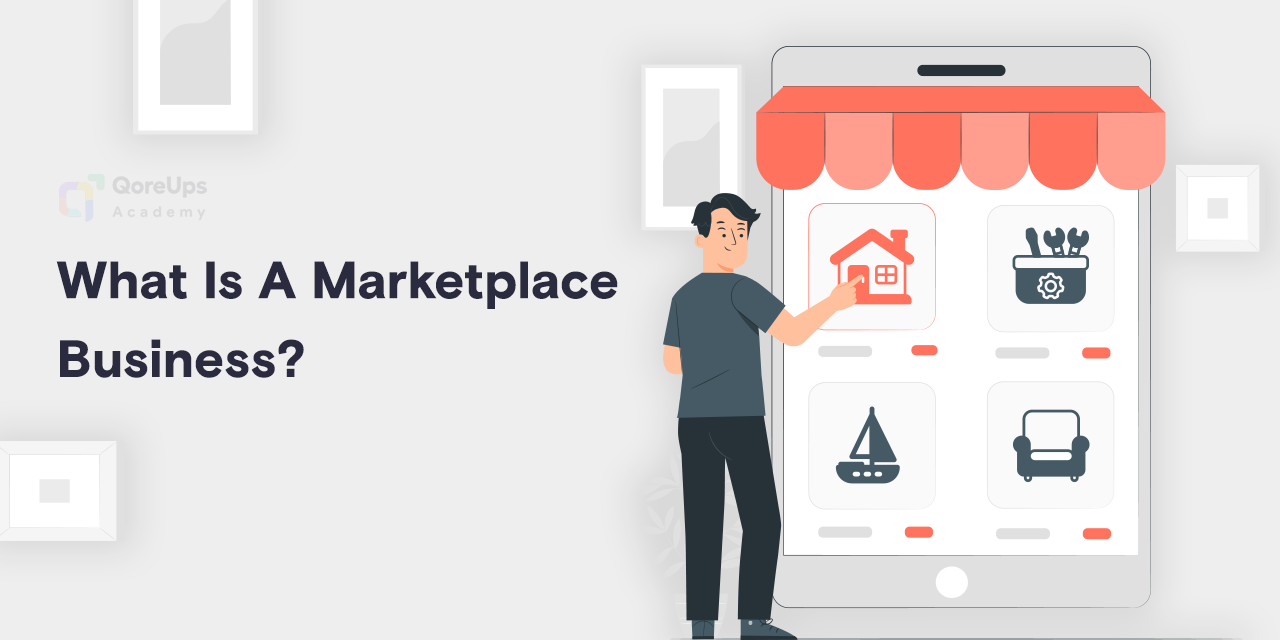In today’s fast-paced digital era, the concept of a marketplace business has gained significant traction.
Understanding what a marketplace business entails, its evolution, benefits, and the intricacies involved in establishing one is essential for entrepreneurs and businesses looking to leverage this model.
This comprehensive guide aims to provide an in-depth overview of marketplace businesses.
It includes types, needs, evolution, benefits, revenue models, statistics, building strategies, challenges, and a summary to encapsulate the key points.
Let’s dive deeper into the blog!
What Is A Marketplace Business
A marketplace business is a platform where buyers and sellers come together to exchange goods, services, or information.
Unlike traditional retail models where a single entity sells products or services to customers, a marketplace acts as an intermediary, facilitating transactions between third-party vendors and consumers.
Examples of popular marketplace businesses include Amazon, eBay, Etsy, and Airbnb.
Key characteristics of a marketplace business include:
- Intermediation: The platform connects buyers with multiple sellers.
- Diverse Offerings: A wide range of products or services is available.
- Scalability: The business can easily scale by adding more sellers and expanding product categories.
- Network Effects: The value of the marketplace increases as more users (both buyers and sellers) join.
Types Of Marketplace For Business
Marketplace businesses can be categorized based on various factors such as the nature of transactions, the target audience, and the type of products or services offered.
Let’s take a look at the different types of marketplace businesses.
Business Model
- B2B (Business-to-Business): Platforms like Alibaba that connect businesses for wholesale transactions.
- B2C (Business-to-Consumer): Platforms like Amazon where businesses sell directly to consumers.
- C2C (Consumer-to-Consumer): Platforms like eBay where consumers sell directly to other consumers.
Product Type
- Goods Marketplaces: Platforms selling physical products, such as Etsy for handmade items or eBay for various consumer goods.
- Services Marketplaces: Platforms offering services, such as Uber for ridesharing or Upwork for freelance work.
- Rental Marketplaces: Platforms like Airbnb for property rentals or Turo for car rentals.
Focus
- Horizontal Marketplaces: Platforms offering a wide range of products or services across multiple categories, like Amazon.
- Vertical Marketplaces: Platforms specializing in a specific niche, like StockX for sneakers or Reverb for musical instruments.
How Marketplace Business Evolved: Offline to Online
The marketplace business model has a long history, evolving from traditional physical markets to sophisticated online platforms.
This evolution brought changes in the way people exchange goods or services.
Also, the shift from offline to online marketplaces has been driven by technological advancement, increased internet penetration, and changing consumer behavior.
Today, online marketplaces leverage sophisticated algorithms, data analytics, and mobile technology to enhance user experience and drive growth.
Let’s look at the transformation in detail.
Traditional Markets
Historically, marketplaces were physical locations where buyers and sellers met to trade goods and services. Examples include town markets, bazaars, and trade fairs.
Catalog Sales
With the advent of mail-order catalogs, businesses could reach a broader audience. Customers could order products from a catalog and have them delivered by mail, laying the groundwork for remote transactions.
Early Online Marketplaces
The Internet revolutionized marketplaces by providing a global platform for buying and selling. eBay, launched in 1995, was one of the first successful online marketplaces, allowing users to auction items to the highest bidder.
Modern Online Marketplaces
Today’s marketplaces leverage advanced technologies like AI, machine learning, and big data to enhance user experience, optimize operations, and provide personalized recommendations.
Examples include Amazon, which uses AI for inventory management and customer suggestions, and Airbnb, which employs machine learning to match guests with properties.
Benefits Of The Online Marketplace Business Model
- Wide Reach: Online platforms can reach a global audience, transcending geographical limitations.
- Low Inventory Risk: Marketplaces typically do not hold inventory, reducing the risk associated with unsold stock.
- Scalability: Adding new sellers and expanding product categories is relatively easy, facilitating rapid growth.
- Cost Efficiency: Lower operational costs compared to traditional brick-and-mortar stores, as physical infrastructure is minimized.
- Revenue Streams: Multiple revenue streams such as commissions, listing fees, subscriptions, and advertisements.
- Data Insights: Access to vast amounts of data helps in understanding market trends, and user preferences, and optimizing business strategies.
- Network Effects: The platform becomes more valuable as more users (buyers and sellers) join, creating a self-reinforcing cycle of growth.
How Does Marketplace Business Make Money?
- Transaction Fees: Charging a percentage of each sale made through the platform. This is common in both goods and services marketplaces.
- Subscription Fees: Offering premium memberships or subscription plans that provide additional benefits or features.
- Listing Fees: Charging sellers a fee to list their products or services on the platform.
- Advertising: Selling advertising space to businesses looking to promote their products or services to the marketplace’s user base.
- Freemium Model: Providing basic services for free while charging for premium features or enhanced visibility.
- Commission: Earning a commission on each transaction facilitated through the platform.
Statistics Of Online Marketplace Business
The online marketplace sector has witnessed exponential growth.
Some key statistics prove that online marketplace business models face huge growth.
- Global Market Size: The global online marketplace market size was valued at over $3.67 trillion in 2023 and is expected to grow at a CAGR of 20% from 2023 to 2030.
- User Base: Major marketplaces like Amazon, eBay, and Alibaba have millions of active users. Amazon, for instance, boasts over 300 million active users worldwide.
- Transaction Volume: In 2023, Amazon reported over $470 billion in gross merchandise volume (GMV), highlighting the massive scale of transactions on these platforms.
- Mobile Commerce: A significant portion of marketplace transactions now occurs on mobile devices, with mobile commerce expected to account for 72.9% of all e-commerce by 2024.
- Growth Drivers: Factors driving growth include increasing internet penetration, the rise of mobile commerce, technological advancements, and changing consumer preferences towards online shopping.
What Are Marketplace Needs?
To create a successful marketplace, understanding its specific needs is crucial.
Take the equipment rental marketplace as an example:
- Trust and Safety: Ensuring secure transactions and maintaining trust between renters and owners is vital. This can be achieved through user verification, reviews, and insurance policies.
- User-Friendly Interface: The platform must be intuitive and easy to navigate, enabling users to search for and rent equipment effortlessly.
- Efficient Logistics: Streamlined processes for the delivery, setup, and return of equipment are essential. This can involve partnerships with logistics providers.
- Transparent Pricing: Clear and competitive pricing models help build trust and attract users. The marketplace price must be visible and fair, often including rental fees, deposits, and any additional charges.
- Customer Support: Offering robust customer support to address issues and provide assistance enhances user satisfaction and loyalty.
- Marketplace Software: Robust marketplace platform software is needed to manage listings, transactions, and communications efficiently. This software should support features like booking management, payment processing, and analytics.
How To Build A Successful Online Marketplace Business – Fast
Building a successful online marketplace requires a strategic approach.
Validate Your Idea
Before diving into development, ensure there is a market need for your marketplace idea.
Conduct market research, surveys, and interviews to gauge interest and identify pain points.
Analyze competitors to understand what works and where gaps exist.
Build a Minimum Viable Platform (MVP)
An MVP allows you to test your marketplace idea with minimal resources.
Focus on core features that solve the primary problem for your users.
Use marketplace platform software to expedite development and reduce costs.
Onboard Your Initial Sellers
Attracting sellers is crucial for kickstarting your marketplace.
Offer incentives, such as reduced fees or marketing support, to onboard initial sellers.
Ensure the onboarding process is seamless and provide tools to help sellers succeed.
Launch and Learn
Launch your marketplace platform to a limited audience and gather feedback.
Use this data to make iterative improvements.
Monitor key metrics like user engagement, transaction volume, and customer satisfaction to guide your adjustments.
Scale
Once you have validated your marketplace and refined the user experience, focus on scaling.
Invest in marketing to attract more users, enhance your technology infrastructure to handle increased traffic, and continuously improve the platform based on user feedback.
Challenges In Online Marketplace Business Model
Despite its advantages, the marketplace business model faces several challenges:
- Building Trust: Establishing trust between buyers and sellers is critical. Implement robust verification processes, secure payment systems, and transparent review mechanisms.
- Managing Supply and Demand: Balancing the number of sellers and buyers is challenging. Too many sellers without enough buyers can lead to dissatisfaction, and vice versa.
- Regulatory Compliance: Navigating different regulations across regions can be complex. Ensure your marketplace complies with all relevant laws, including data protection and consumer rights.
- Competition: The marketplace space is highly competitive. Differentiating your platform and maintaining a unique value proposition is essential.
- Technology: Maintaining and upgrading marketplace software to handle growing user bases and transactions requires continuous investment and expertise.
Summing Up
The marketplace business has transformed the way we buy and sell goods and services, leveraging technology to create dynamic, scalable platforms that connect buyers and sellers globally.
From its evolution from offline to online, the marketplace business continues to grow, offering significant benefits and opportunities.
However, building a successful online marketplace requires careful planning, execution, and ongoing optimization to address the inherent challenges and capitalize on the vast potential of this business model.
In 2024 and beyond, the marketplace business is poised to continue its rapid growth, driven by technological advancements, changing consumer behaviors, and the increasing demand for convenience and variety.
For entrepreneurs and businesses, understanding the dynamics of marketplace businesses and staying ahead of trends will be key to thriving in this competitive landscape.






